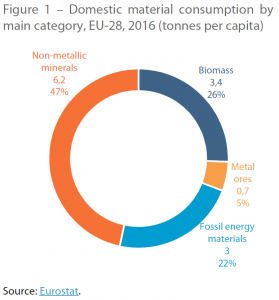Primary raw materials can be grouped into four main categories of materials: fossil energy materials, which refer to all non-renewable energy sources such as coal, natural gas or crude oil; biomass, which includes non-fossil materials of biological origin such as wood, crops, dairy and other foods; metals, which not only include metal ores but also all the materials derived from a mine for the extraction of metals; and non-metallic minerals, which include materials such as sand, gravel and fertiliser minerals.
In the EU, non-metallic minerals (mainly used as construction material) account for almost half of all materials used by weight. Their use can be strongly affected by changes in the economic situation. For these reasons, non-metallic minerals have a large influence on the overall development of domestic material consumption. Between 2007 and 2014, for example, the use of non-metallic minerals fell by 31 %, inducing a 20 % decline in overall domestic material consumption.
After they have been used, products and materials can be recycled and re-used as secondary raw materials. According to Eurostat data, the contribution of recycled materials to the overall raw materials demand has, however, stayed rather low for most materials. The contribution of recycled materials to the overall demand is highest for metal ores, which however account for only a small share of the total use of materials by weight








Be the first to write a comment.